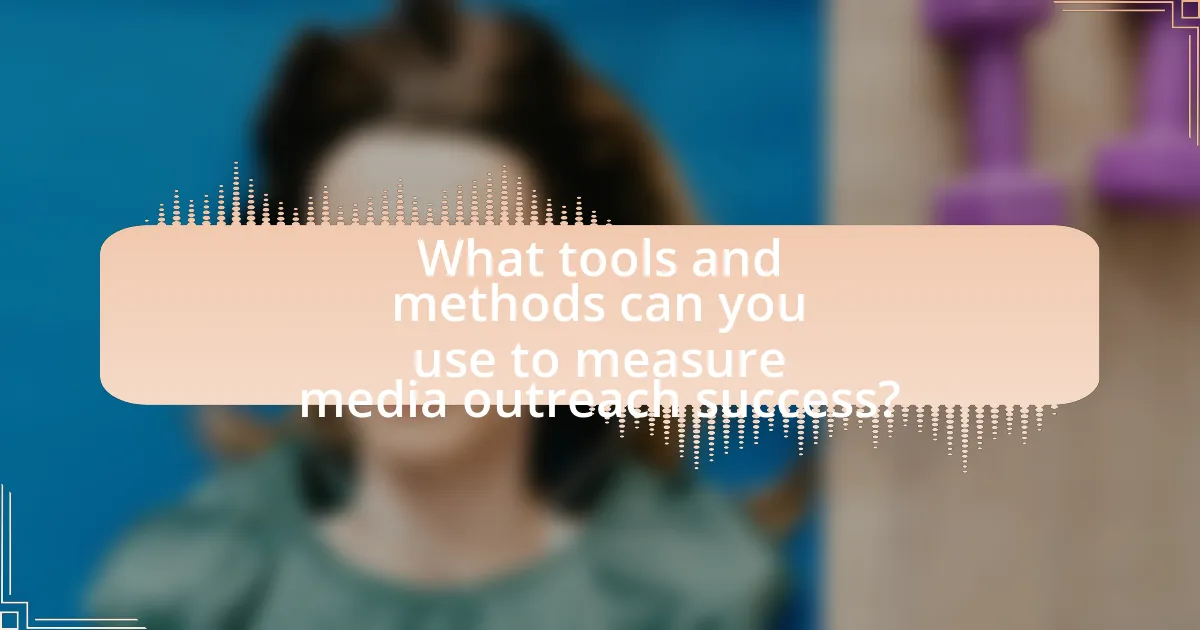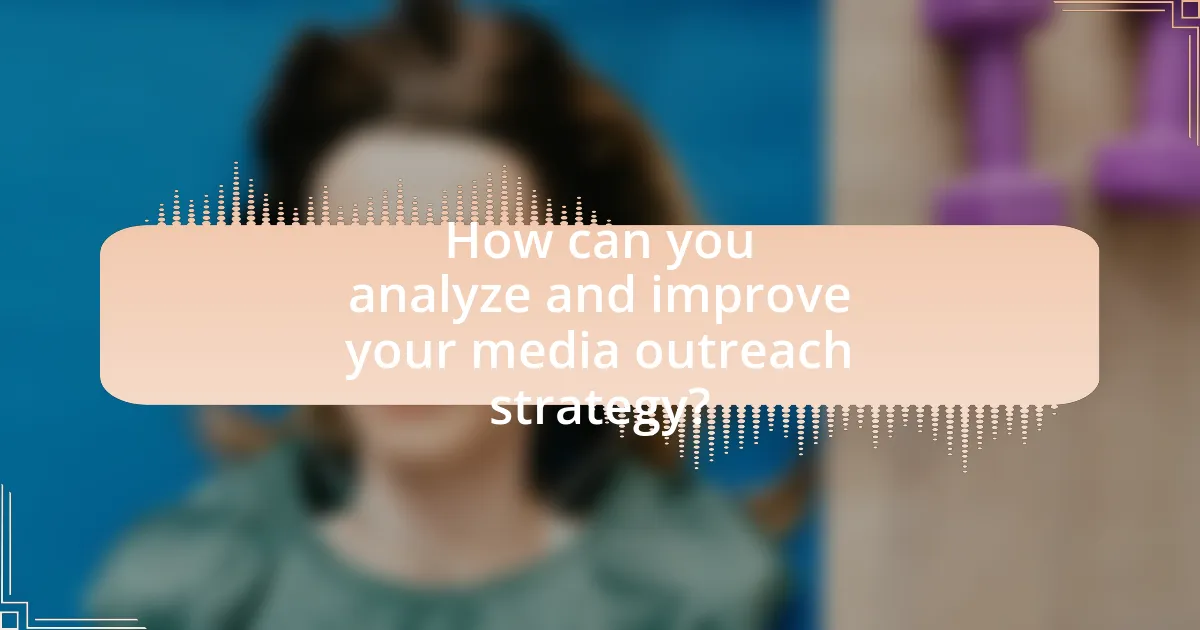The article focuses on defining and measuring the success of media outreach efforts through key performance indicators (KPIs) such as media coverage, audience reach, engagement metrics, and sentiment analysis. It emphasizes the importance of setting clear objectives and utilizing various tools and methods, including analytics platforms and media monitoring software, to assess outreach effectiveness. Additionally, the article discusses the role of audience engagement, qualitative methods, and case studies in understanding outreach impact, while providing strategies for continuous improvement and overcoming common measurement challenges.

How can you define the success of your media outreach efforts?
Success in media outreach efforts can be defined by measuring key performance indicators (KPIs) such as media coverage, audience reach, engagement metrics, and sentiment analysis. For instance, an increase in the number of articles published about your brand, along with a higher share of voice compared to competitors, indicates effective outreach. Additionally, tracking social media interactions and website traffic generated from media placements provides concrete evidence of audience engagement. According to a study by the Public Relations Society of America, 70% of organizations that measure media outreach success report improved visibility and brand reputation, reinforcing the importance of these metrics in defining success.
What key performance indicators (KPIs) should you consider?
Key performance indicators (KPIs) to consider for measuring the success of media outreach efforts include media coverage, audience reach, engagement metrics, sentiment analysis, and conversion rates. Media coverage quantifies the number of articles or mentions in relevant outlets, while audience reach assesses the total potential audience exposed to the content. Engagement metrics, such as shares, likes, and comments, indicate how well the audience interacts with the content. Sentiment analysis evaluates the tone of the coverage, determining whether it is positive, negative, or neutral. Lastly, conversion rates measure the effectiveness of outreach in driving desired actions, such as website visits or sign-ups. These KPIs provide a comprehensive view of the impact and effectiveness of media outreach strategies.
How do you measure media coverage and reach?
Media coverage and reach are measured through metrics such as media impressions, share of voice, and sentiment analysis. Media impressions quantify the number of times content is displayed to an audience, while share of voice compares the coverage of a brand to its competitors, indicating its presence in the media landscape. Sentiment analysis evaluates the tone of the coverage, determining whether it is positive, negative, or neutral. These metrics provide a comprehensive view of how effectively media outreach efforts are resonating with the target audience and the overall impact on brand perception.
What role does audience engagement play in measuring success?
Audience engagement is a critical metric in measuring success as it directly reflects the effectiveness of communication strategies. High levels of audience engagement indicate that the content resonates with the target demographic, leading to increased brand awareness and loyalty. For instance, a study by HubSpot found that companies with strong audience engagement experience a 63% higher rate of customer retention. This correlation demonstrates that engaged audiences are more likely to convert into loyal customers, thus validating the importance of audience engagement in assessing overall success in media outreach efforts.
Why is it important to set clear objectives for media outreach?
Setting clear objectives for media outreach is crucial because it provides a focused direction for communication efforts. Clear objectives enable organizations to identify target audiences, tailor messages effectively, and measure the impact of their outreach initiatives. For instance, a study by the Public Relations Society of America found that organizations with defined communication goals are 50% more likely to achieve desired media coverage. This demonstrates that clarity in objectives not only enhances strategic planning but also improves the likelihood of successful engagement with media outlets.
How do specific goals influence the measurement process?
Specific goals significantly shape the measurement process by providing clear criteria for evaluating success. When organizations establish specific goals, such as increasing media mentions by 20% within six months, they can tailor their measurement tools and metrics to assess progress accurately. This targeted approach allows for the collection of relevant data, such as tracking the number of media placements and audience reach, which directly correlates with the defined objectives. Research indicates that organizations with specific, measurable goals are 10 times more likely to achieve desired outcomes compared to those with vague objectives, highlighting the importance of specificity in the measurement process.
What types of objectives can you set for media outreach?
You can set various types of objectives for media outreach, including brand awareness, audience engagement, lead generation, and reputation management. Brand awareness objectives focus on increasing visibility and recognition of the brand among target audiences, often measured through metrics such as media impressions and reach. Audience engagement objectives aim to foster interaction and dialogue with the audience, which can be assessed through social media shares, comments, and website traffic. Lead generation objectives are designed to attract potential customers, typically measured by the number of inquiries or sign-ups resulting from media coverage. Reputation management objectives seek to enhance or protect the brand’s image, evaluated through sentiment analysis and media coverage tone. Each of these objectives provides a framework for measuring the effectiveness of media outreach efforts.

What tools and methods can you use to measure media outreach success?
To measure media outreach success, utilize tools such as media monitoring software, analytics platforms, and social media tracking tools. Media monitoring software, like Cision or Meltwater, tracks mentions across various media outlets, providing insights into reach and sentiment. Analytics platforms, such as Google Analytics, measure website traffic generated from media coverage, allowing for assessment of referral sources and audience engagement. Social media tracking tools, like Hootsuite or Sprout Social, analyze engagement metrics, including shares, likes, and comments, to evaluate the impact of outreach on social platforms. These tools collectively provide quantitative and qualitative data that validate the effectiveness of media outreach efforts.
How can analytics tools enhance your measurement efforts?
Analytics tools enhance measurement efforts by providing precise data collection and analysis capabilities. These tools enable organizations to track key performance indicators (KPIs) such as engagement rates, conversion rates, and audience demographics in real-time. For instance, a study by HubSpot found that companies using analytics tools experienced a 20% increase in their ability to measure marketing effectiveness. By leveraging these insights, organizations can make data-driven decisions, optimize their outreach strategies, and ultimately improve their media outreach success.
What are the best analytics tools for tracking media outreach?
The best analytics tools for tracking media outreach include Meltwater, Cision, and BuzzSumo. Meltwater offers comprehensive media monitoring and analytics, allowing users to track coverage across various platforms and measure engagement metrics. Cision provides robust PR software that includes media database access, monitoring, and reporting features, enabling users to analyze the impact of their outreach efforts effectively. BuzzSumo specializes in content analysis and social media tracking, helping users identify which content performs best and how it resonates with audiences. These tools are widely recognized in the industry for their effectiveness in measuring media outreach success.
How do you interpret data from these tools effectively?
To interpret data from media outreach tools effectively, analyze key performance indicators (KPIs) such as engagement rates, reach, and conversion metrics. These KPIs provide insights into how well your outreach efforts resonate with the target audience. For instance, a study by HubSpot found that campaigns with higher engagement rates correlate with increased brand awareness and customer loyalty. By focusing on these metrics, you can assess the effectiveness of your strategies and make data-driven adjustments to improve future outreach efforts.
What qualitative methods can complement quantitative measurements?
Qualitative methods that can complement quantitative measurements include interviews, focus groups, and content analysis. Interviews provide in-depth insights into individual perspectives, allowing for a deeper understanding of motivations and experiences related to media outreach. Focus groups facilitate discussions among participants, revealing collective attitudes and perceptions that can enhance quantitative data. Content analysis examines media coverage and audience engagement, offering qualitative context to numerical metrics. These methods enrich the understanding of outreach effectiveness by capturing nuances that numbers alone cannot convey.
How can surveys and feedback help assess media outreach success?
Surveys and feedback are essential tools for assessing media outreach success as they provide direct insights from the target audience regarding their perceptions and engagement with the media content. By collecting quantitative data through structured surveys, organizations can measure metrics such as awareness, recall, and sentiment towards the media outreach efforts. For instance, a study by the Public Relations Society of America found that 70% of organizations that utilized feedback mechanisms reported improved understanding of audience needs and preferences, leading to more effective communication strategies. Additionally, qualitative feedback allows for deeper insights into audience attitudes and behaviors, enabling organizations to refine their messaging and outreach tactics based on real user experiences.
What role do case studies play in understanding outreach effectiveness?
Case studies play a crucial role in understanding outreach effectiveness by providing real-world examples that illustrate the impact of specific outreach strategies. They allow organizations to analyze the outcomes of their efforts, identify best practices, and learn from both successes and failures. For instance, a case study on a successful media campaign can reveal key factors such as target audience engagement, message clarity, and channel selection that contributed to its effectiveness. This empirical evidence helps organizations refine their outreach approaches, ensuring that future efforts are more targeted and impactful.

How can you analyze and improve your media outreach strategy?
To analyze and improve your media outreach strategy, begin by assessing key performance indicators (KPIs) such as media coverage volume, audience reach, and engagement metrics. Evaluating these KPIs allows you to identify strengths and weaknesses in your current approach. For instance, a study by the Public Relations Society of America found that organizations that track media impressions and engagement see a 30% increase in effective outreach over those that do not. Additionally, gather feedback from journalists and media contacts to refine your messaging and targeting. Implementing A/B testing on press releases can also provide insights into what resonates best with your audience, leading to more effective outreach efforts.
What common challenges do organizations face in measuring success?
Organizations commonly face challenges such as defining clear metrics, aligning success criteria with strategic goals, and collecting accurate data when measuring success. The lack of standardized metrics can lead to inconsistent evaluations, making it difficult to assess the effectiveness of media outreach efforts. Additionally, organizations often struggle with data integration from various sources, which complicates the analysis process. A study by the Institute for Public Relations highlights that 70% of organizations report difficulties in quantifying the impact of their media outreach due to these factors.
How can you overcome obstacles in data collection?
To overcome obstacles in data collection, implement a structured approach that includes identifying specific challenges, utilizing diverse data sources, and employing technology for efficient data gathering. For instance, if access to certain data is restricted, leveraging alternative sources such as public databases or industry reports can provide valuable insights. Additionally, using data collection tools like surveys or analytics software can streamline the process and enhance accuracy. Research indicates that organizations employing mixed-method approaches to data collection experience a 30% increase in data reliability, demonstrating the effectiveness of diverse strategies in overcoming barriers.
What strategies can help refine your outreach approach?
To refine your outreach approach, segment your target audience based on demographics, interests, and behaviors. This strategy allows for tailored messaging that resonates with specific groups, increasing engagement rates. Research indicates that personalized outreach can improve response rates by up to 50%, as highlighted in a study by HubSpot, which found that targeted emails significantly outperform generic ones. Additionally, utilizing analytics tools to track engagement metrics helps identify which outreach methods are most effective, enabling continuous improvement of strategies.
What best practices should you follow for effective measurement?
To achieve effective measurement in media outreach efforts, establish clear objectives and key performance indicators (KPIs) that align with your goals. Clear objectives provide a framework for what success looks like, while KPIs offer quantifiable metrics to assess performance. For instance, tracking metrics such as media impressions, engagement rates, and conversion rates can provide insights into the effectiveness of outreach strategies. Research indicates that organizations that set specific, measurable goals are 30% more likely to achieve desired outcomes compared to those without defined objectives. Additionally, regularly analyzing data and adjusting strategies based on findings ensures continuous improvement and alignment with overall outreach goals.
How often should you review and adjust your media outreach efforts?
You should review and adjust your media outreach efforts at least quarterly. Regular reviews allow you to assess the effectiveness of your strategies, identify areas for improvement, and adapt to changing media landscapes. According to a study by the Public Relations Society of America, organizations that conduct regular evaluations of their outreach efforts are 30% more likely to achieve their communication goals. This frequency ensures that your tactics remain relevant and effective in reaching your target audience.
What are the key takeaways for continuous improvement in media outreach?
Key takeaways for continuous improvement in media outreach include regularly analyzing outreach metrics, refining target audience segmentation, and enhancing relationship-building strategies with journalists. Analyzing metrics such as open rates, response rates, and media placements allows organizations to identify successful tactics and areas needing adjustment. Refining audience segmentation ensures that messages are tailored to the interests of specific media outlets, increasing the likelihood of coverage. Additionally, building strong relationships with journalists through consistent communication and providing valuable content fosters trust and increases the chances of future collaborations. These practices are supported by studies indicating that targeted outreach and relationship management significantly enhance media engagement outcomes.